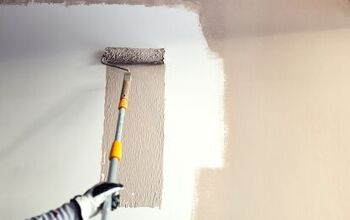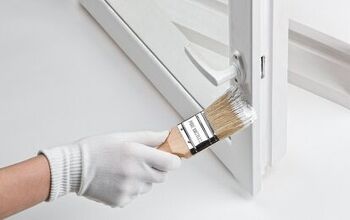Can You Paint Canvas Awnings? (Find Out Now!)

Over time, canvas awnings do fade and eventually, they will no longer complement the exterior of your home. When this happens, many homeowners consider the more economical option of painting the canvas instead of replacing the entire awning. Whether your canvas awning has faded or you simply want to change the color and give it an updated look, you may be wondering: “can you paint canvas awnings?”
Fortunately, as long as the canvas is in reasonable condition and there are no signs of rot, you can paint a canvas awning. Though possible, painting canvas awnings can be relatively difficult because they don’t hold paint as well as wood and require thorough preparation. You must carefully clean and stretch the canvas prior to painting.
Despite being a bit of a challenge, painting a canvas awning can restore the color and extend its life by at least another year, potentially more.
Do You Need Painting or Staining Services?
Get free, zero-commitment quotes from pro contractors near you.

Overview of Canvas Awnings
Due to their affordability, canvas awnings are often preferred over metal or other fabric types. Canvas is very durable, has a longer lifespan than other alternatives, and is easier to replace than other awning types.
Opting for a canvas awning means that you have a wider variety of designs and patterns to choose from. Though, these designs will fade over time and will need to replaced, reapplied, or painted over.
Why Paint Canvas Awnings?
When your awnings start to fade, the only two options are to replace them or paint them. The most common reason why a homeowner may choose to paint a canvas awning has to do with cost. Painting is a very economical option for refreshing your canvas awnings without breaking the bank.
The cost to buy a new canvas awning ranges from $300 to $700 each. Whereas, painting a canvas awning only costs about $12 to $20 per square meter, or approximately $1 to $2 per square foot.
What Type of Paint Do You Use on Canvas Awnings?
Although you can paint canvas awnings, they are notoriously difficult to paint since canvas does not hold paint as well as a material like wood. Moreover, these awnings are going to be constantly exposed to the most severe weather conditions. With that said, you cannot use any sort of paint that is water-soluble, and many other paint options will simply chip off of the material.
For best results, acrylic paint should be used, as it is water-resistant and incredibly durable. It’s also important that you mix in a fabric medium to ensure that the paint stays flexible after drying. Before the awning can be reinstalled, the paint must be given ample time to dry and then treated appropriately.
Another option for painting on a canvas awning is fabric paint. Although fabric paint is commonly reserved for more delicate items like outdoor sofas, cushions, and pillows, awnings are often included in the list of suitable materials that fabric paint can be used on. Fabric paint can be purchased in aerosol cans, offering a much easier application process than acrylic paint.
Canvas Awning Preparation
The most important step in painting canvas awnings is the preparation. You must thoroughly clean the canvas and allow sufficient time for it to dry before any paint can be applied. Canvas awnings are often very dirty due to extended use and exposure to the elements. In order for the paint to properly adhere, all existing layers of dirt must be removed first.
After the canvas has dried, it must be stretched and suspended. This will allow for easier application of the paint and a more even color absorption. Whether you decided on an acrylic or fabric paint, you should always test it on a small, inconspicuous section of the awning before you start painting.
That way, you can see how the paint reacts to the canvas when it dries and avoid any undesirable results. Once you’re comfortable enough with the process, you can proceed with painting the entire awning.
How to Paint Canvas Awnings
Painting, using the recommended acrylic paint method, should be done carefully following these easy steps:
- Mix your paint with a fabric medium to enhance flexibility.
- Apply the paint using a standard paintbrush in a liberal manner.
- Let the canvas dry for at least 24 hours before sealing.
When you’re deciding a day to paint your canvas awning, try to choose one that has no rain in the forecast. This will give you at least a full day for the awning to dry without any troubles.
Sealing Canvas Awnings
After you’ve finished painting the awning, there are a number of sealants that can be applied to protect the new layer of color and waterproof the canvas surface. Though not required, it’s highly recommended to seal the canvas awning after painting. The sealant provides an additional layer or protection, extending its life in harsh weather conditions.
Apply the sealant after the paint has dried, and consider following up with an additional seal or waterproofing layer.
What Color Should I Paint My Canvas Awnings?
Generally speaking, you have three main options when it comes to painting your awnings: you can paint them the same color, go darker, or opt for a lighter color. Painting darker is the easiest option, as colors like steel blue, crimson, or black will easily cover the faded fabric. Going with a lighter color is always more difficult and may require several layers of paint. Whereas, if you choose to go with the same color, it’s crucial that you get the closest match possible.
Do You Need Painting or Staining Services?
Get free, zero-commitment quotes from pro contractors near you.

Related Questions
How much paint do I need to paint a canvas awning?
One gallon of paint will be sufficient to cover roughly 350 square feet, meaning a quart of paint is enough for an 8-foot by 10-foot canvas awning.
Can I use interior paint on my canvas awning?
We highly advise that you do not use interior paint on an awning, as this type of paint it more rigid and more susceptible to cracking. It can also cause the fabric to tear, as it must be flexible enough to bend in the wind.Moreover, most types of interior paint are not engineered to withstand moisture and this can cause the color to fade much faster than expected.

Jessica considers herself a home improvement and design enthusiast. She grew up surrounded by constant home improvement projects and owes most of what she knows to helping her dad renovate her childhood home. Being a Los Angeles resident, Jessica spends a lot of her time looking for her next DIY project and sharing her love for home design.
More by Jessica Stone



























